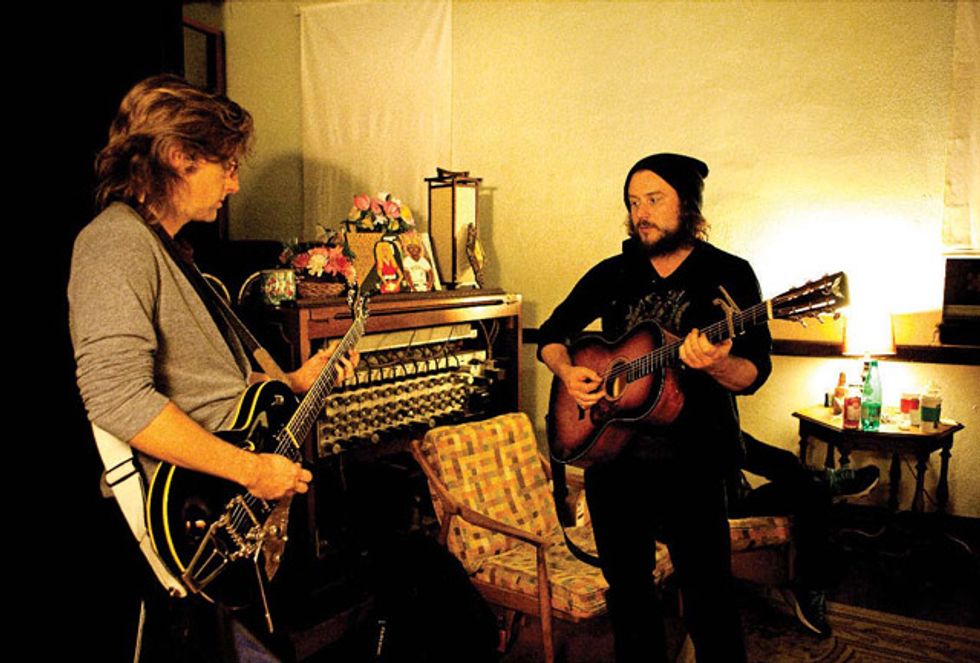
Carl Broemel (left) and his duesenberg Starplayer tV collaborate in the studio with vocalist Jim James and his custom Breedlove Revival 000. Photo by Roderick Norman Trestrail II
Over the last decade, My Morning Jacket has proven itself to be perhaps the contemporary band most adept at absorbing and mixing country, folk, rock ’n’ roll, gospel, funk, and soul. So adept, in fact, that they were invited to open for Neil Young. And their Coachella and Bonnaroo performances over the last few years have been genuinely epic (their 35-song 2008 Bonnaroo set lasted four hours and featured guest appearances by Metallica’s Kirk Hammett and The Hangover’s Zach Galifianakis). Led by singer/guitarist Jim James’ falsetto hollers and smooth crooning, the Louisville, Kentucky, outfit has managed to consistently capture and distil the essence of American musical origins, as evidenced by everything from the raw, lo-fi raggedness of 1999’s The Tennessee Fire to 2008’s sultry, Grammy-nominated Evil Urges. The current lineup—founders James and bassist Tom Blankenship, along with guitarist Carl Broemel, drummer Patrick Hallahan, and keyboardist Bo Koster—has been together since 2005’s Z, which happened to be the album when their heavy Americana leanings really burst forth. Coinciding with that subtle shift was a greater affinity for keys, soaring guitar breaks, and eclectic surprises such as the single “Highly Suspicious”—which had a wah-fueled funk riff like something you’d hear from Prince.
But MMJ’s latest album, Circuital—with its gentle fingerpicked passages, spacious echoes, gorgeous vocal harmonies, and winsome pedal-steel lines—marks something of a return to the band’s roots, And it’s no doubt due at least partially to a three-year break, during which many members of the band explored other musical outlets. James formed the super group Monsters of Folk (with singer-songwriter M. Ward, and Conor Oberst and Mike Mogis of Bright Eyes) and recorded an EP of George Harrison covers under the name Yim Yames. Meanwhile, Broemel played on various sessions, including rockabilly star Wanda Jackson’s latest album, and Hallahan toured with the Black Keys’ Dan Auerbach in support of his 2009 solo album Keep It Hid. Whatever the reason, Jacket’s latest outing is more lushly atmospheric and acoustic-driven than their last two efforts—although there are some notable exceptions: “Holdin’ on to Black Metal” has a Thai-soul sound, with funky horn stabs and electric piano grooves, while “You Wanna Freak Out” features a gloriously fuzzed-out, square-tooth-filtered guitar solo.
“I feel like solo acoustic material has always been a part of MMJ,” James says when asked if his stint in Monsters of Folk contributed to the sparser sound of Circuital. “Our records usually feature one or two tunes that are pretty simple. I’ve always liked taking a minute to boil it down and space out.” A prime example of the sort of sound James is referring to is “Wonderful (The Way I Feel)”—a hymn to simple pleasures that finds James indulging in twinkling acoustic arpeggios and intermittent string-section filigrees.
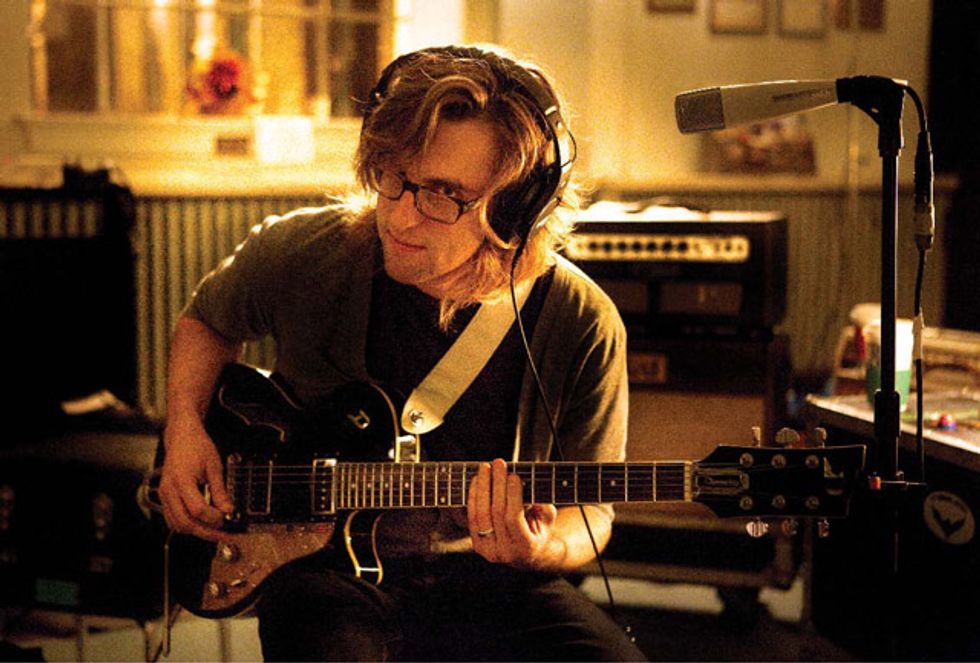
Broemel tracking Circuital with his duesenberg Starplayer TV and a Carr rambler head routed
through a top hat cabinet. Photo by Roderick Norman Trestrail II
Live at the Gymnasium
One of the more interesting—and kudos-deserving—things about Circuital is that the vast majority of tracks were recorded live in a rather sonically unfriendly environment.
“This was such a fun record to make,” says James. “We just set up in a beautiful old gym from the early 1900s and kept the gear real simple—just our tape machine and some nice mics.”
“We discovered we’re innately happier there than in a proper recording studio,” agrees Broemel. “It’s fun to have no reason to look at a ticking clock or have to say ‘Oh, the drums always sound great over here’—to be in a space that doesn’t feel as if it’s been used for what you’re using it for. We got some overdubs done in Brick and Stone Studios in Nashville, and I love it. It’s an amazing studio—so much equipment— but they have pictures of the Beatles everywhere. When you’re trying to record your songs, you don’t want to look at pictures of the Beatles. C’mon, it’s a little intimidating! [Laughs.] In the gym, we were in our own universe, which is the best place for us.”
Pedal-Steel Preparations
Another reason Circuital feels like a return to form for MMJ is because the albums prior to Broemel’s arrival had a lot of pedal- steel playing. But apparently Broemel has spent the last four years training himself on the instrument, because it adds a familiarly soaring, classic-country vibe to “Outta My System,” “Holdin’ on to Black Metal,” “You Wanna Freak Out” and “Movin’ Away.”
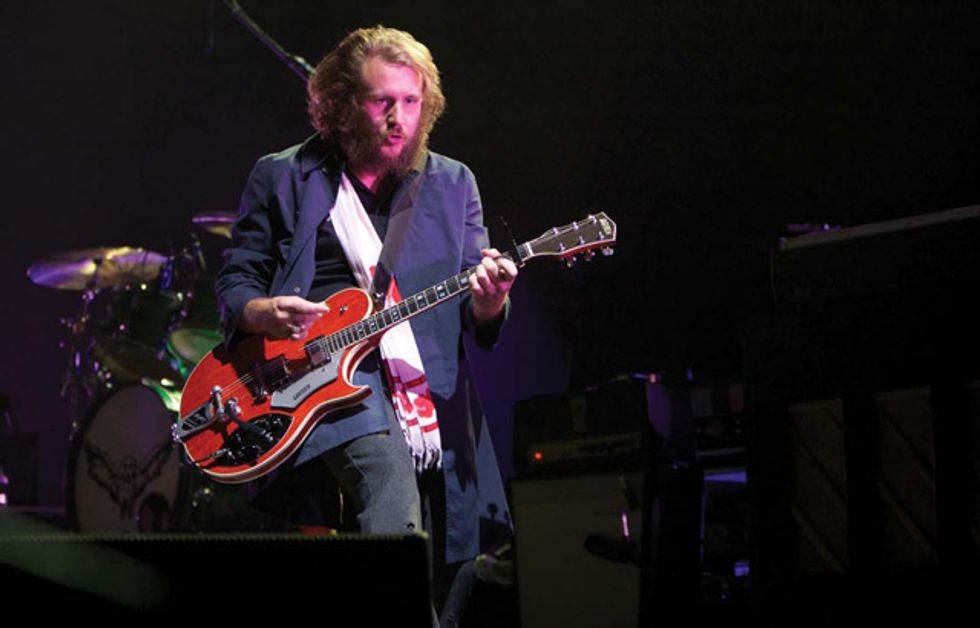
James with his Gretsch Super Axe and a 3 Monkeys Orangutan half-stack at the Charter One
Pavillion in Chicago on August 17, 2010. Photo by Andy Keil
“I had always been curious about it,” he admits. “I love country music and I love the sound of pedal steel, but I didn’t know how to play it, how it was set up, or even how many strings it had. I found a really great teacher and he gave me a couple of lessons and showed me how it relates to the guitar,” explains Broemel. “There’s been so much amazing stuff done with it in country and swing and jazz, and I try to be conscious of that—but I’m not trying to master it. I treat it more as an ambient thing. I’m just applying it to what we do and trying to make sounds that I feel like I haven’t heard yet. Now, sitting down and playing it is one of my favorite things about being in the band. I’m kind of a beginner, so I just use it for what I know I can pull off without falling on my face.”
In addition to constituting a return to classic MMJ form, pedal steel also boosts Broemel’s creativity on his main instrument. “I love the guitar, but sometimes you get burned out and go ‘I don’t even know what to do!’ When that happens, I’ll play pedal-steel guitar for a while, and having to think about the theory and how the instrument works and then going back to guitar helps me picture the fretboard differently. You get a different perspective.”
A Lot of Gear for a “Minimal” Rig
Whether crafting eerie shimmers or slashing at minor chords with a reverb-drenched overdrive, Broemel has a surprising amount of gear for a man who says he likes to keep his setup minimal. One of his favorite new pieces is a German-made Duesenberg. “Until this record, I used all Les Pauls, all the time. I bought a couple of Duesenberg guitars after the last record—my friend runs a studio in Indiana and he had a couple, including a 12-string that I used on a session there. So I bought the Double Cat 12-string, and then a guy from Duesenberg brought me a Starplayer TV, which is kind of their version of a Gibson ES-335 and has the Bigsby on it—and I love Bigsbys. I’ve always had Bigsbys on my favorite black Les Paul Standard, my main guitar. I used the Starplayer for the whole record, basically. The neck’s a little bit longer scale than a Les Paul, and it’s the only hollowbody I have. The older songs don’t feel right on the Duesenberg, but the newer songs do, so it’s cool that an instrument is dictating how I play and making me play a little bit differently. It’s like a hi-fi, fancy guitar—like a BMW guitar. It’s too nice for me!” he laughs.
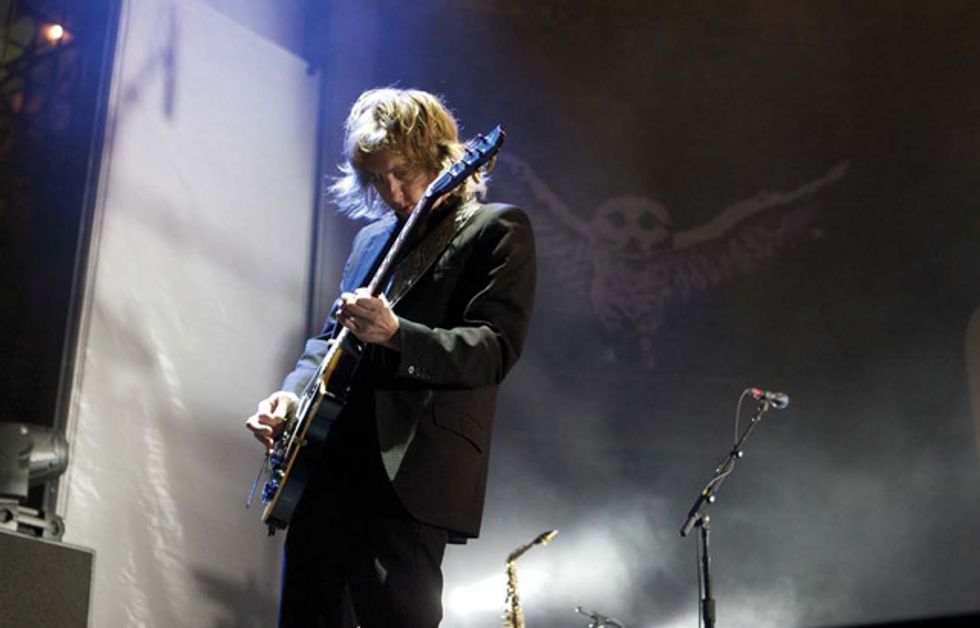
Broemel and his Bigsby-outfitted 1988 Gibson Les Paul Standard at the Charter
One Pavillion in Chicago on August 17, 2010. Photo by Andy Keil
As for amps, Broemel says, “I’ve always been partial to combos. I’ve always used pedals for overdrive, so I just look at what’s going to work live and be really flexible and play all the songs on it. But it’s such a slippery slope—you can go chasing those zenith guitar sounds, but what’s the point? Do you want to sound like Stevie Ray Vaughan or just like Jimmy Page? Or Jimi Hendrix? I don’t really care about that. If it sounds like me—if that’s possible—then great. I’ve been using a Carr Rambler live, and I love that. I also have a couple of old Fenders. I have a Vibrasonic, as well, which I use for the pedal steel—it’s a silverface with a 15" speaker.”
James stuck to his tried-and-true guitars, including a 1999 Gibson Flying V and a Breedlove Revival Custom acoustic. Amps-wise, he waxes lyrical about a new discovery: “I have finally found an amp I love both on the road and in the studio— the 3 Monkeys Orangutan. It is unreal how versatile this amp sounds. It can truly do everything. I feel like I’m doing a product endorsement right now,” he admits. “But I’m really being serious. The amp sounds amazing and it looks beautiful, too—like the monolith from 2001: A Space Odyssey or something. God bless that amp.”
Given MMJ’s Americana emphasis, one would correctly surmise that James and Broemel don’t use a lot of strange effects— though both have a wide selection of echo, reverb, and overdrive pedals. Indeed, Jacket seems to exist in a cloud of reverb, so the two guitarists’ attention in this area is no real surprise. But what might be surprising is the lack of full-on vintage love and the embrace of many new boutique stompboxes, including models from SIB, Z.Vex, EarthQuaker Devices, Malekko, Durham Electronics, and Boss.
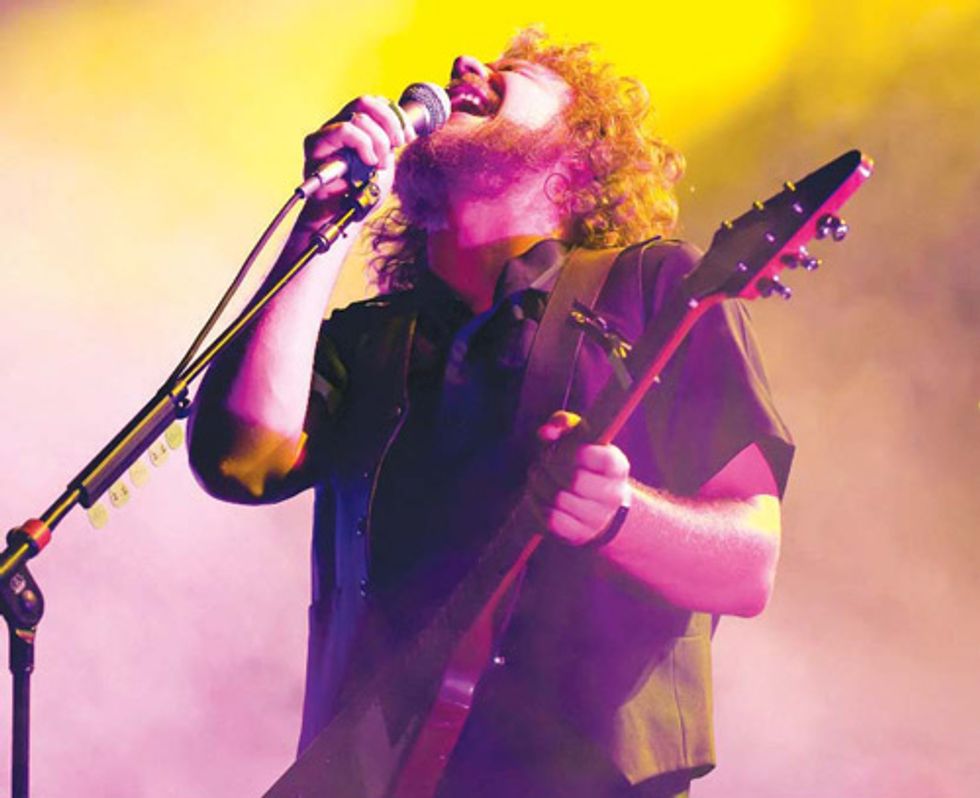
James Howling as he grips his 1999 gibson flying V. Photo by Linda Park
That said, Broemel is pretty adamant about the necessity of one vintage-styled piece of signal-altering gear. “I’ve got one of those Tube Tape Echos,” he says of the treasured Fulltone unit he used on pretty much every Circuital song. “That thing is unbelievable. That and great amps are all you need in the studio. I try not to use too much, though—only what I need.”
Finding a Balance
Another reason why Circuital sounds a little more reigned-in than some of MMJ’s recent albums is the more supportive role that the guitars play. Whereas past MMJ tunes like “Gideon,” “It Beats 4 U,” and “Touch Me I’m Going to Scream, Pt. 1” had more central guitar refrains, this set is very much about delectable songs that create an irresistible mood.
“I feel the guitar is far more effective on record when it’s used sparingly,” James says, “but live it translates very well and provides a lot of excitement. So, I try to find balance between those two worlds.”
Here Broemel cuts in to add some context. “We approach all the instruments equally. As much as we try to experiment and try to use keyboards or saxophones or something to pull the weight of the midrange where the guitar would typically go, a lot of times we’d end up saying ‘Y’know, the guitar is the best thing there.’”
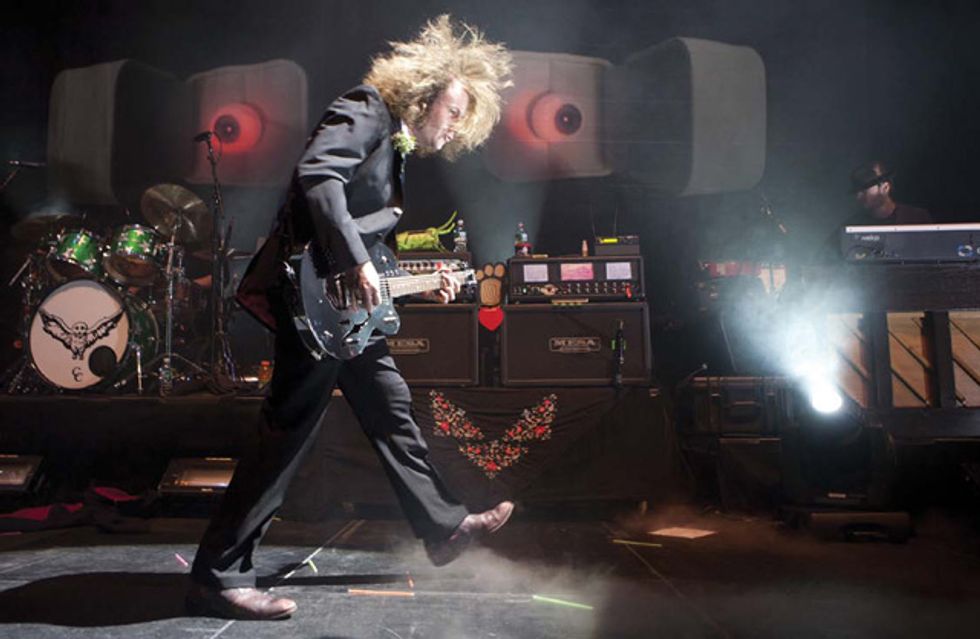
James on the prowl with a Normandy Guitars Archtop plugged into Carr rambler (left) and
Mesa/Boogie Tremoverb heads, each powering a Boogie 2x12, at a 2008 New Year’s eve
gig at Madison Square Gardens. Photo by Jackie Roman
As an example of the type of egalitarian musicianship that’s more prevalent on Circuital, one need look no further than the build-up of the opening track, “Victory Dance”: A gong and a heraldic electric-piano refrain lead into spoken-word vocals that slowly build to a crescendo of strings and sparse, slapback-tinged electrics that snap here and there before tremolo-goaded chords warble and swell into out-of-control feedback and the whole song gets sucked into a frenetic vortex of sound. But Broemel feels the title track has the album’s finest guitar spot: Clean, palm-muted electric arpeggios and James’ lilting voice set a lovely, optimistic mood before the choruses lift you a little higher with John Mellencamp-like acoustic splashes and bristling power-chord stabs, and then, more than five minutes into the seven-plus-minute song, Broemel and Hallahan ratchet up the pulse with crashing snare and cymbals, a bunch of Bigsby wobbling, soaring melodies, and a series of joyous descending double-stops—all with impeccable tone that speaks volumes with a delectable minimalism.
“I consider that a flashy guitar solo— that’s the big guitar moment for me,” Broemel says. “Being flashy just isn’t that important to me. I remember thinking, ‘There’s plenty of space for me to play a solo in this song . . . I could do that and that and that.’ When we were done with the main tracks, everybody went, ‘I think we’re done,’ and I was like, ‘Wait a minute— I was just trying to get stuff together during that. That can’t be it!’ I was totally bummed. We finished that session, went home, reconvened, and tried to record the song again, but we just couldn’t redo it— I’d grown accustomed to the solo I played and I was like ‘Thank God it is what it is!’ Jim’s vocal vibe, the weird piano notes, all the things that happened in that moment— they can’t be replicated. I don’t think it’s the most unbelievable guitar solo ever played, but it’s something I’m glad we caught.
“And that’s been the huge lesson of this record,” Broemel continues. “It’s all about intent versus just letting it happen. If you try to play it well, it’s terrible! If you’re just playing for the sake of playing—if you can somehow get to that place where you get something neat that you didn’t intend to do—that’s better than something you would’ve come up with logically.”
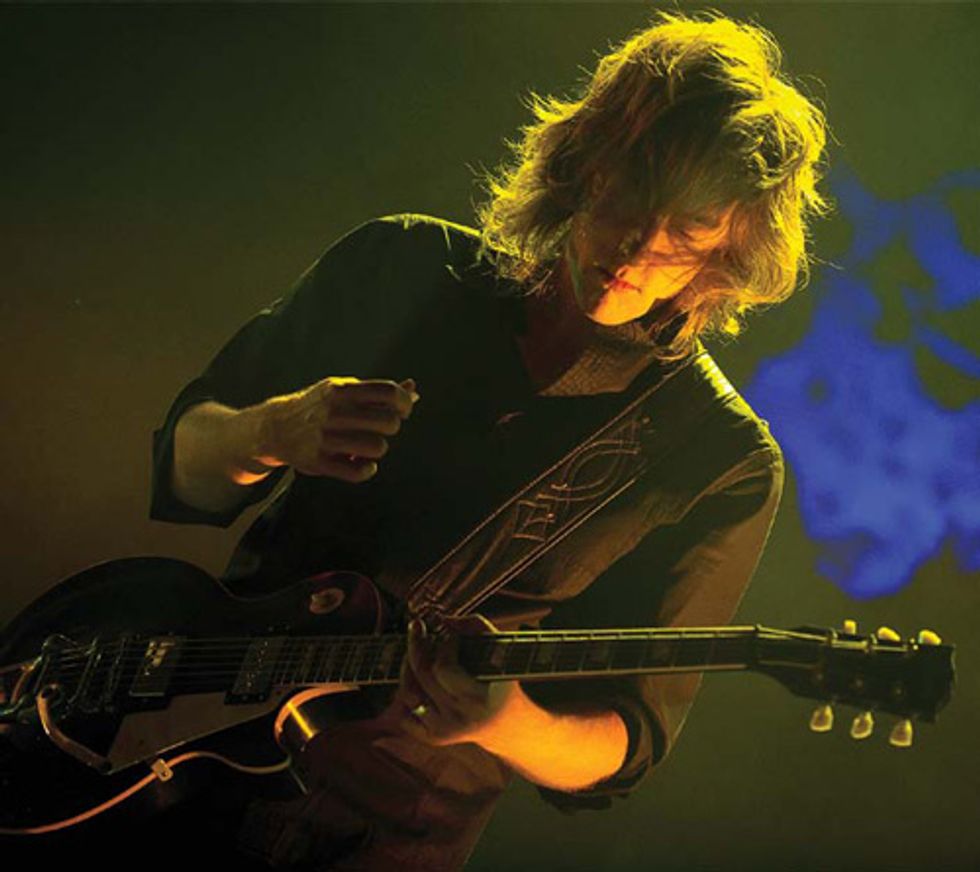
Broemel listens to the atmospheric kerrang of an 11th-fret power chord ringing out through
his ’88 Les Paul Standard’s bridge pickup. Photo by Chris Schwegler
Carl Broemel’s Gearbox
Guitars
Duesenberg Starplayer TV, Duesenberg Double Cat 6/12, 1988 Gibson Les Paul Standard with Bigsby, Gibson goldtop Les Paul with P-90s, reissue Gibson Les Paul Junior, GFI S-10 pedal-steel guitar
Amps
Carr Rambler, Carr Vincent, vintage Fender Vibrolux, vintage Fender Princeton Reverb, vintage Fender Vibrasonic (for pedal steel)
Effects
Keeley Compressor (two-knob), Electro-Harmonix Micro POG, Electro-Harmonix Freeze (“My new favorite pedal!”), Fulltone Fulldrive 2, Fulltone PlimSoul, Fulltone Tube Tape Echo, Durham Electronics Sex Drive, Eventide ModFactor, Eventide TimeFactor, SIB Mr Echo, Boss RV-5 Digital Reverb, Hilton Volume Pedal (for pedal steel), Fulltone Fat-Boost (pedal steel), SIB Mr Echo (pedal steel), Boss DD-6 Digital Delay (pedal steel), Eventide ModFactor (pedal steel)
Strings and Picks
D’Addario EXL 115s (electric), Jim Dunlop Tortex .73 mm
Jim James’ Gearbox
Guitars
Custom 2008 Breedlove Revival 000, ’50s Martin 000, Gibson J-185, Gretsch Super Axe, 1999 Gibson Flying V, 1975 Fender Strat, two Gibson ES-335s
Amps
3 Monkeys Orangutan head and 2x12 cabinet, Mesa/Boogie Tremoverb head
Effects
Boss BD-2 Blues Driver, Boss RV-3 Digital Reverb/ Delay, Boss TU-2 Tuner, SIB Mr Echo, Z.Vex Box of Rock, Z.Vex Woolly Mammoth, EarthQuaker Devices Monarch overdrive, EarthQuaker Devices Ghost Echo, Malekko Spring Chicken reverb
Strings and Picks
D’Addario EXL115 sets (electric), and D’Addario EJ17 sets (acoustic), Jim Dunlop Tortex .88 mm










![Rig Rundown: Russian Circles’ Mike Sullivan [2025]](https://www.premierguitar.com/media-library/youtube.jpg?id=62303631&width=1245&height=700&quality=70&coordinates=0%2C0%2C0%2C0)












![Rig Rundown: AFI [2025]](https://www.premierguitar.com/media-library/youtube.jpg?id=62064741&width=1245&height=700&quality=70&coordinates=0%2C0%2C0%2C0)




















 Zach loves his Sovtek Mig 60 head, which he plays through a cab he built himself at a pipe-organ shop in Denver. Every glue joint is lined with thin leather for maximum air tightness, and it’s stocked with Celestion G12M Greenback speakers.
Zach loves his Sovtek Mig 60 head, which he plays through a cab he built himself at a pipe-organ shop in Denver. Every glue joint is lined with thin leather for maximum air tightness, and it’s stocked with Celestion G12M Greenback speakers.











